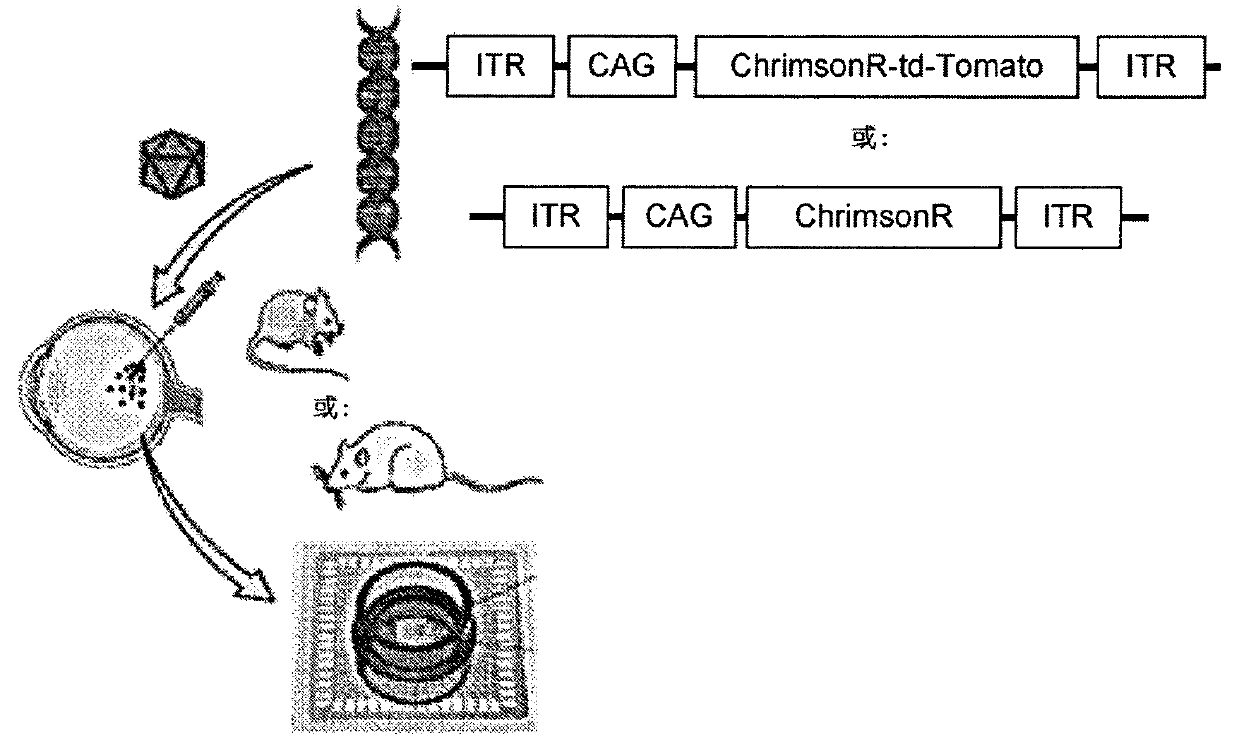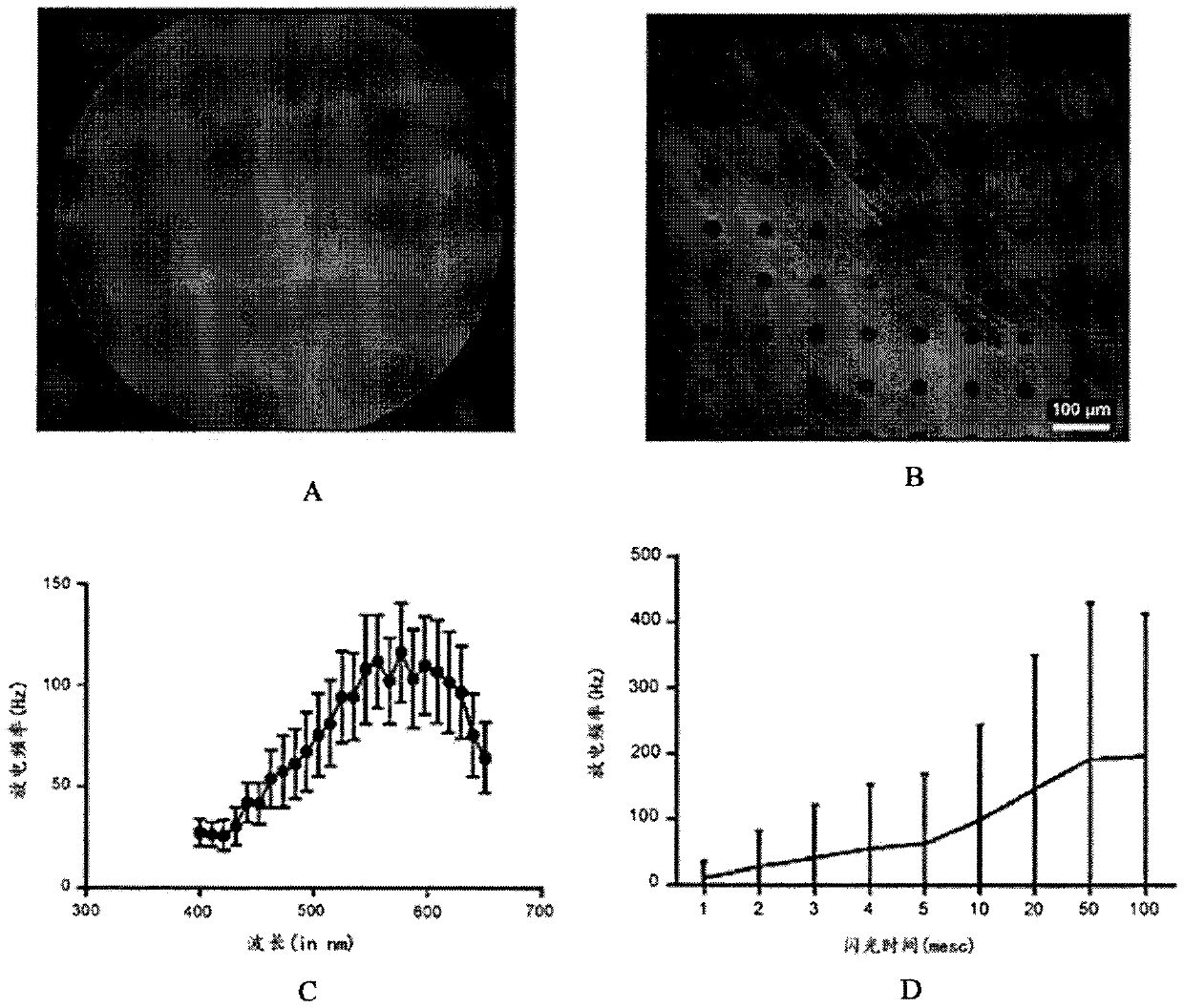Optogenetic visual restoration using chrimson
A use, vision technology, applied to the use of exogenous light-activated ion channels in cells and target subjects, Chrimson polypeptides, reactivation of mammalian retinal neurons in the field of cells, able to solve unproven, no opsin activity improvement, expression Issues such as differences in level or membrane positioning
- Summary
- Abstract
- Description
- Claims
- Application Information
AI Technical Summary
Problems solved by technology
Method used
Image
Examples
Embodiment 1
[0168] Example 1: Validation of rdl and P23H Denatured Rodent Models
[0169] Retinal dystrophies are associated with retinal cell dysfunction and degeneration, impairing the flow of visual information and ultimately leading to severe vision loss and blindness. Retinitis pigmentosa (RP) is the most common retinal dystrophy, causing 1 in 4000 vision loss worldwide. RP is composed of more than 60 genes that are inherited as autosomal dominant (30%-40% of cases), autosomal recessive (50%-60%) or X-linked (5%-15%) caused by a change in any one gene.
[0170] In most common forms of RP, rod photoreceptors degenerate first, followed by cone degeneration. Therefore, early symptoms of RP are often night blindness and tubular vision due to peripheral vision loss. All RP conditions are progressive, with varying characteristics of visual deterioration across patients, but blindness is the ultimate result. There is no known treatment for RP.
[0171] Because RP is caused by multiple ...
Embodiment 2
[0209] Example 2: Activation of Retinal Ganglion Cell Populations in Non-Human Primates Below Safe Radiation Limits
[0210]In the above studies, we have demonstrated that ChrimsonR (ChrR), a red-shifted opsin, can induce photoactivation of retinal ganglion cells (RGCs) in blind rodents (rdl mice and P23H rats). In addition, we observed that an extended form of ChrR fused to the fluorescent protein tdTomato appeared to provide greater functional utility in terms of the number of light-responsive cells and the amplitude of their responses. It is known that AAV2 transduces only RGCs in the underside of the concave ring in nonhuman primates compared to rodents (Yin et al., 2011). AAV2-7m8, extends beyond the foveal ring, leading to islands of expression in peripheral regions (Dalkara et al., 2013). Similar transduction features of AAV2 vectors are expected to occur in humans. Therefore, to further assess the translational potential of this therapeutic intervention, we here asse...
Embodiment 3
[0237] Embodiment 3: the effect of fluorescent protein tdTomato in the expression and localization of optogenetic protein ChrimsonR
[0238] AAV2.7m8-CAG-ChrimsonR-tdTomato was much more potent than a similar construct lacking tdTomato (AAV2.7m8-CAG-ChrimsonR) in nonhuman primates and rdl mice with retinitis pigmentosa. Therefore, our goal was to understand its underlying mechanism. To this end, we performed in vitro studies in HEK293 cells focusing on the expression and delivery of ChrimsonR alone or fused to tdTomato. method
[0239] Human HEK293 cells were seeded in 24-well plates in DMEM medium supplemented with 10% fetal bovine serum. The confluence of the cells (Confluence) was 10% to 70%, used between the 3rd and 20th passages. Cell transfection of pssAAV-CAG-ChrimsonR-tdTomato, pssAAV-CAG-ChrimsonR and pssAAV-CAG-ChrimsonR-GFP plasmids was performed using As a transfection agent (1 μl in 50 μl buffer mixed with 0.5 μg of plasmid DNA).
[0240] ChrimsonR, Chrims...
PUM
| Property | Measurement | Unit |
|---|---|---|
| wavelength | aaaaa | aaaaa |
Abstract
Description
Claims
Application Information
 Login to View More
Login to View More - R&D
- Intellectual Property
- Life Sciences
- Materials
- Tech Scout
- Unparalleled Data Quality
- Higher Quality Content
- 60% Fewer Hallucinations
Browse by: Latest US Patents, China's latest patents, Technical Efficacy Thesaurus, Application Domain, Technology Topic, Popular Technical Reports.
© 2025 PatSnap. All rights reserved.Legal|Privacy policy|Modern Slavery Act Transparency Statement|Sitemap|About US| Contact US: help@patsnap.com



